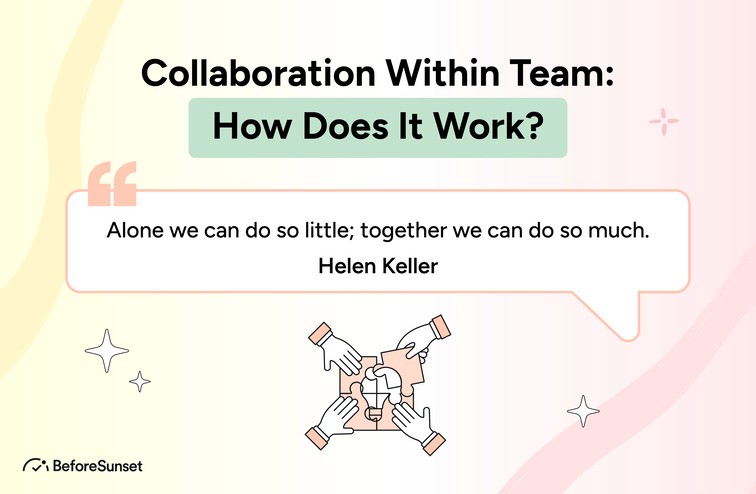Effective team collaboration is a planned, well-orchestrated effort that combines coordination, cooperation, and communication. It doesn't happen by accident.
In this blog, we set out on a quest to understand the inner workings of team cooperation, probing the crucial tenets, tactics, and dynamics that support its accomplishment. We will examine the factors that cause teamwork to not just function, but to thrive, including the nuances of good communication, the function of leadership, and the advantages of cohesive teamwork.

What Are The Three Types of Collaboration Skills?
In today's linked world, when teamwork and cooperation are crucial for success in a variety of personal, professional, and academic undertakings, collaboration is one of the crucial skill sets. Working together is only one aspect of effective cooperation; people also need a certain set of abilities to be able to contribute well to a group endeavor. Three main categories of these talents stand out as the cornerstones of effective collaboration.
1. Communication skills
A vital set of talents called communication skills enables people to successfully communicate information, ideas, emotions, and feelings to others. These abilities are crucial for successful interpersonal interactions, career advancement, and a variety of social interactions. In addition to speaking and writing, effective communication also entails active listening and nonverbal cues. Here are a few crucial communication skills components:
Verbal Communication: Included in this category are spoken and written words. Using the right language, syntax, and tone is essential for verbal communication that is clear and succinct. It involves communicating your ideas and thoughts in a way that your audience can understand them.
Non-Verbal Communication: Non-verbal clues include eye contact, gestures, body language, and facial expressions. These signs can communicate attitudes, emotions, and intentions. Your capacity to appropriately communicate can be greatly improved by being aware of and employing non-verbal communication well.
Listening Skills: Effective communication involves more than simply talking; it also involves paying attention. Giving the speaker your undivided attention while also seeking clarification and exhibiting empathy are all examples of active listening. It's essential to developing meaningful conversations and understanding other people.
Empathy: Empathy is a critical component of good communication because it allows us to comprehend and sympathize with the feelings and viewpoints of others. To better understand someone else's sentiments and points of view, you must put yourself in their position.
Conciseness and Clarity: Being clear and succinct in your communication helps avoid miscommunication. Make sure your message is simple to understand by staying away from jargon and extraneous complications.
Adaptability: Various audiences and circumstances may call for various communication strategies. A crucial talent is the ability to adjust your communication style to the demands of your audience.
Conflict Resolution: The ability to communicate well is crucial for dispute resolution. In both personal and professional contexts, the capacity to voice problems, hear others' points of view, and work toward mutually accepted solutions is essential.
Feedback: Constructive feedback-giving and receiving are crucial for both professional and personal development. Specific, implementable, and presented in a helpful manner are qualities of effective feedback.
Digital Communication: Emails, texts, and other internet platforms are often used for communication in the modern world. It's crucial to know how to conduct yourself professionally and politely when using these digital channels.
Cultural Sensitivity: In varied and globalized contexts, it is especially important to be conscious of and tolerant of cultural variations in communication techniques.
2. Emotional intelligence
The term "emotional quotient" (EQ), often known as "emotional intelligence" (EI), refers to a person's capacity to comprehend, manage, and successfully employ their own emotions as well as those of others. It is essential to both personal and professional success because it affects how people connect with others, resolve disputes, and make decisions. Key elements of emotional intelligence include the following:
Self-Awareness: The cornerstone of emotional intelligence is self-awareness. It entails identifying and comprehending your own emotions, as well as the causes of them and how they affect your behavior. Self-aware people can identify their strengths and faults with accuracy.
Self-Regulation: Self-regulation is the capacity to regulate and control one's emotions, particularly in demanding or stressful circumstances. It entails being composed under duress, restraining irrational impulses, and adjusting to shifting conditions with poise.
Motivation: Having a strong desire to accomplish one's personal and professional objectives is referred to as motivation in the context of emotional intelligence. People with high EI are frequently self-motivated, tenacious in the face of obstacles, and forward-thinking.
Empathy: The capacity for empathy is the capacity to comprehend and experience another' feelings. It entails paying attention to others' feelings, carefully listening to what they have to say, and expressing compassion and understanding. Relationships may be robust and helpful when people are empathic.
Social Skills: Effective social skills include a variety of capabilities, such as communication, dispute resolution, relationship development, and maintenance. People with strong emotional intelligence are adept at navigating social situations, communicating effectively, and cooperating in teams.
3. Respect for diversity
Respect for diversity is a fundamental concept and practice that recognizes and celebrates the differences between people and groups. It is also known as diversity and inclusion (D&I). It includes acknowledging, respecting, and valuing the distinctive qualities, backgrounds, viewpoints, and experiences that individuals offer to a group, organization, or society. Here are a few crucial components of respecting diversity:
Inclusion: Diversity and inclusion go hand in hand. It involves fostering an atmosphere where everyone, regardless of their history, identity, or skills, feels accepted, respected, and able to engage completely. Removing obstacles and prejudices that can restrict the contributions of particular people or groups is a key component of inclusive practices.
Respect and Acceptance: Regardless of differences, respect for diversity entails treating everyone with dignity. It entails realizing that each individual has intrinsic value and deserves to be treated with respect and fairness.
Equity: Equity is the idea of maintaining justice and fairness for everyone while taking into consideration any institutional hurdles or historical disadvantages that some groups may have experienced. It entails making an effort to eliminate disparities and provide everyone a chance.
Education and Awareness: Promoting tolerance for diversity requires an awareness of many cultures, identities, and viewpoints. Programs for education and awareness can assist people in discovering and appreciating the richness of variety.
Empathy: Empathy is essential for valuing variety. Empathy requires making an effort to comprehend the struggles, experiences, and emotions of others, especially those from diverse backgrounds, and demonstrating empathy can result in encounters that are more inclusive and encouraging.
Fair Treatment: A fundamental aspect of valuing diversity is treating everyone equally and without prejudice. It entails refraining from treating others unfairly because of traits like color, ethnicity, gender, sexual orientation, religion, handicap, or age.
Promoting Representation: It's critical to support varied representation within an organization or community. It guarantees that all views and viewpoints are heard and taken into account during the decision-making process.
Resolution of Conflicts: Disagreements or misunderstandings can lead to conflicts in varied situations. Respecting diversity entails finding common ground, retaining respect for all parties involved, and resolving issues via open and polite conversation.
Legal Compliance: Discrimination is forbidden by laws and regulations in many nations, which also encourage variety. Respecting diversity entails abiding by these rules and advocating for a system of laws that guarantees everyone equal rights and opportunities.
Continuous Improvement: Fostering an appreciation for diversity is a process that is always being improved. It necessitates a dedication to ongoing development, introspection, and a readiness to alter and grow as cultural standards and expectations do.

Why is Team Collaboration Important?
When varied abilities, viewpoints, and experiences are pooled together, collaboration may achieve great things that are impossible for one person to do alone. In this section, we explore the significant relevance of team cooperation and explore the persuasive arguments for why it serves as a driving force for creativity, problem-solving, and accomplishing common goals.
Good Team Collaboration Encourages Better Problem-Solving
As it exploits the collective intelligence, varied views, and integrated talents of team members, effective team collaboration is a catalyst for enhanced problem-solving. Individuals work together in a collaborative atmosphere to provide a favorable environment for creative solutions.
There is a greater probability of developing novel solutions and tackling unspoken difficulties when there are a variety of points of view on the issue. Collaboration also promotes open communication, helpful criticism, and the sharing of ideas, which leads to better solutions.
Individual teams that work well together are also frequently productive, which makes them more adaptable and receptive to challenging problem-solving situations. In the end, effective teamwork is the crucible in which complicated issues are dissected, examined, and successfully resolved with increased inventiveness.
Good Team Collaboration Gives a Broader Perspective
A wider viewpoint is a priceless asset of effective team cooperation. When people with various experiences, perspectives, and backgrounds work together on a project or issue, they each bring a plethora of unique ideas to the table.
Due to this diversity, the team is able to explore a variety of viewpoints and strategies, which results in a deeper comprehension of the problem at hand. A more comprehensive understanding of the issue and its solutions results from the individual perspectives of each team member.
By questioning presumptions and revealing unique ideas that may have stayed hidden in a less diverse and collaborative workplace, this larger viewpoint not only improves the quality of decision-making but also stimulates creativity.
Good Team Collaboration Supports Knowledge Sharing
A strong catalyst for knowledge sharing within a group is effective team cooperation. It promotes open communication and the unrestricted sharing of knowledge, ideas, and skills among team members.
People are more inclined to contribute their views, best practices, and lessons learnt from previous experiences in a collaborative setting. Each team member's comprehension is improved by the knowledge exchange, and the group's collective intelligence is also strengthened.
A culture of learning and progress is fostered when team members consistently share their knowledge and benefit from one another. The team as a whole will benefit from a wealth of shared information thanks to this dynamic process, which will eventually improve decision-making, problem-solving, and overall team performance.
Good Team Collaboration Improves Employee Engagement and Happiness
A sense of belonging and purpose among team members is fostered through effective team cooperation, which in turn greatly raises employee engagement and satisfaction. People who cooperate well frequently feel more satisfied with their jobs because they believe their contributions are respected and that their perspectives are being heard.
Collaboration fosters a positive workplace culture where workers are more likely to be inspired and engaged in their jobs. Working together and exchanging ideas with coworkers may improve morale and foster a great working culture, which will further encourage engagement and happiness.
Additionally, as a result of the collective sense of achievement shared by collaborative teams when they succeed in their aims, workers become more enthused about their work and their contributions to the team's success.

10 Tips for Building Team Collaboration
Establish Clear Goals: Set definite objectives and make sure everyone in the team is aware of the team's priorities, objectives, and anticipated results. Clearly defined objectives give collaboration a shared cause.
Effective Communication: Promote clear and honest communication for effective communication. Provide a variety of communication channels, including meetings, emails, and collaboration tools, to encourage team members to communicate ideas, feedback, and information often.
Define Roles and Responsibilities: Clarify each team member's function and duties inside the group by defining their respective roles and obligations. It helps to know who is responsible for each activity to avoid confusion and wasted effort.
Leverage Diverse Skills: Recognize and make use of each team member's special talents, experiences, and abilities. Innovation and problem-solving are improved by diversity.
Set Expectations: Clear expectations should be set for team members' behavior and performance. Establish criteria for cooperation, courtesy, and professionalism.
Encourage Inclusivity: Establish a welcoming workplace where every team member—regardless of their experience, viewpoint, or position—feels respected and heard.
Regular Check-Ins: Schedule frequent team check-ins or meetings to monitor progress, talk about obstacles, and make sure everyone is on the same page.
Provide Resources: Give the team the resources they need to do their job successfully, including the tools, training, and resources.
Celebrate Success: Highlight and honor both team and individual successes. A sense of success and drive are fostered through recognition.
Continuous Improvement: Encourage a culture of continuous development by asking team members for input and using it to gradually improve teamwork and processes.
How BeforeSunset AI Helps With Team Collaboration
With BeforeSunset AI's up-and-coming team function, working hybrid will be a breeze. Get ready for this team collaboration tool. Try hybrid work models with BeforeSunset AI.

